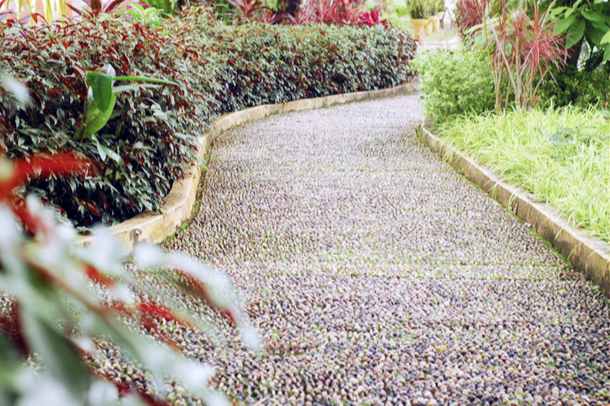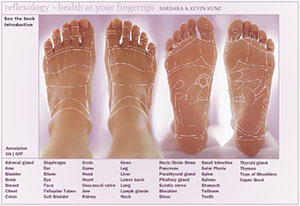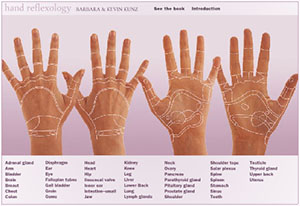History of the Path
History of Reflexology Paths
To the bare-footed reflexology path users around the world, the proof is in what they’ve been doing for years. The bare-footed exercise is grounded in the traditions of its location. Special paths have been built in parks, spas, condominium complexes and country clubs across Asia. In Germany and Austria, one embarks on a hike through nature with bare feet making contact with specially selected surfaces. Ideas of “acupoints” in Asia and “reflexzonmassage” in Germany tie the walking to the health of the whole body.
History of the reflexology path in Asia
In Asia, the history of the reflexology path begins with cobblestone paths. Cobblestone was the common building material for paths and roads. One elderly Japanese remembers villagers volunteering their time to repair the roads near the village. The availability of these surfaces for transportation probably lead informally to the tradition of walking on them for health.
“In nearly every village in Taiwan they have built special paths of pebbles and every morning at 3 or 4 o’clock, people walk barefoot around the pebble path for a half hour before they go to work. Hundreds, even thousands do this. It has become a way of life. I think this is very important. We eat three times a day for our health. For me it is like praying or meditation, I need it for my bodily health and I think every body needs it.”
Father Josef Eugster, (British) Reflexions
Barbara and Kevin Kunz currently speculate that the recent interest and building boom in cobblestone paths in Asia is a further impact of the work of one man, Father Josef Eugster. Thanks to the work of this Swiss Jesuit priest who heads a parish in Taiwan attention was rekindled in ancient Chinese foot working traditions some twenty- five years ago. Since that time foot work has spread throughout Asia. All across Asia, in China, Malaysia, Taiwan, Hong Kong, Japan, and Singapore, the impact has reverberated. Reflexology practitioners have set up shop. Singapore’s Chinatown is known for its reflexology clinics. Singapore malls include reflexology businesses.
Japanese tourists travel to Taiwan to experience the work of that country’s reflexology practitioners. A Japanese woman who operates a chain of reflexology parlors in Japan is noted to be one of Japan’s leading taxpayers. Research is conducted by Chinese medical doctors and reflexology is a common therapy in the Chinese medical system.
History of the reflexology path in Germany
In Germany and Austria, attention has been paid to the feet throughout history. Both water and pressure applied to the feet are traditionally seen to impact the whole body. One traditional practice, kneippen, popularized by Pastor Sebastian Kneipp in the 1800’s, consists of “wading” on wet grass or in shallow water to stimulate the internal organs, strengthen the immune system, and help the body to heal itself.
“Reflezonmassage” began in the early 1900’s simultaneously with the development of zone therapy in the US. The practices were both further refined to the application of pressure techniques to the feet to impact specific parts of the body. Today, some call the Barefoot Path ” do-it-yourself” reflexology. In the tradition of Kneipp, walkers on the Barefoot Path might have access to “kneippen,” a walk through water with rocks.
American awareness of reflexology paths
American reflexologists first became aware of Asian interest in walking on varied surfaces for health purposes following presentations at the Rwo Shr Health ’90 Worldwide Conference Tokyo in July 1990. (The organization is named for Father Josef. Rwo Shr is Mandarin Chinese for Josef.) Participants Barbara and Kevin Kunz became interested and, over the years, have written about the ideas surrounding the presentations. The 1990 presentations were: “Healthy Stroll Path” at a Shiseido factory in Japan, a scientific study of walking on a beaded mat, and a moving personal account of the benefits of walking on a varied surface by the 80 year-old Mr. Keichi.
Differences and similarities between reflexology paths of Asia and Europe
The similarities between Asian and European traditions and paths are striking: (1) Traditions of doing something actively to impact one’s health; (2) Traditions of doing something to one part of the body to impact the whole body; (3) Traditions of doing something to specific parts of the feet to impact specific parts of the body; (4) Doing something natural to improve one’s health; (5) Use of materials found commonly in one’s surroundings to construct paths; (6) Building paths in public areas; and (7) Use of the paths as an inducement to entice potential visitors or customers.
The differences are striking as well: (1) The size of the path system – compact in Asia and sprawling in Europe. Think 75 m. in Asia and 3500 m. in Europe; (2) The surface underfoot – cobblestone in Asia and mud, logs, stone, moss and more in Europe; (3) Stone placement – embedded in concrete in Asia and loose on the ground in Europe; (4) The sensory experience – varied surface in Asia with the addition of balance opportunities in Europe. (Interestingly, Asian traditions also include takefumi, stepping on bamboo as well as tai chi with its practice of balance.)









